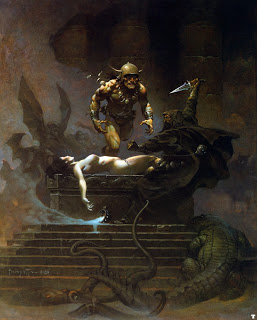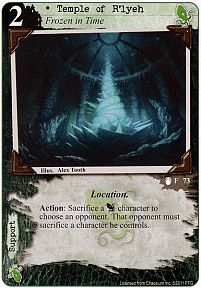APPENDIX 3: CLERICAL QUICK REFERENCE CHART
-
APPENDIX 3: CLERICAL QUICK REFERENCE CHART
-
|
|
|
|
|
This listing has been provided by quick reference when specific information
about a cleric's religion is needed.
Deities are arranged alphabetically within their pantheon, except that
the most important deity is listed first.
The information presented here is to be used as guidelines only --
all clerics of one deity will not necessarily dress identically, for example.
Rank within the temple is often differentiated by variations in color,
lining or stripes, etc.
Special sacrifices and holy days may be ordained at any time, or the
pleasure of the temple (or its deity).
Clerics Raiment Sacrifice/Propitiation
| Sphere of Control | Animal | M | F | N-H | Head | Body | Color(s) | Holy Days | Frequency | Form | Place of Worship |
SPHERE OF CONTROL: This refers to the item, condition, or element over which the deity exerts some measure of control (e.g. Air, Rain, The Hunt, Affairs of the Heart, etc.).
ANIMAL: The animal or animals listed here
are the ones most commonly associated with or sacred to that deity.
Clerics of this deity will often protect this type of animal.
Some deities are not associated with an animal, however.
CLERICS: This describes whether the clerics
of this deity can be male (M), female (F), or non-human (N-H).
Q: Can a character
worship a deity
from the pantheon of another
race?
Why or why not?
A: Yes, he can, but
he might find himself
outcast, accepted neither
by his own race
nor the race associated
with the deity. This
depends on how appropriate
the deity is
for the character. The Greek
deity
Hephaestus, for example,
is very appropriate
for dwarves or gnomes. Likewise,
deities who are associated
with a particular
class are generally appropriate
for any
character of that class
regardless of race.
A dwarven worshiper of a
giants? deity,
however, is likely to be
unwelcome wherever
he goes. Clerics are a different
matter;
refer to the individual
descriptions of
each deity to determine
which races the
deity will accept as clerics.
(144.6)
RAIMENT: This is the prescribed form of
adornment for a cleric of the deity.
This may include: robes, headdresses, hairstyles, tattoos, makeup,
physical disfigurations (e.g. a notched ear, misshapen head, etc.), ornaments
or jewelry, footwear, etc.
COLOR(S):
This lists the colors, if any, associated with the deity or its clerics.
Items using these colors might include ceremonial robes, altar drapings,
candles, holy banners, etc.
HOLY DAYS: This listing gives the highest
holy days associated with a deity and its worshipers.
Sacrifices, rituals, and prayers on these days are more likely to be
heard and acknowledged by the deity.
Note that acknowledgement is not the same thing as granting
a prayer or request!

Listed here are both the frequency and form of sacrifices expected of
the worshipers of this deity.
In +addition+,
tithings and actual sacrifices should be made by a dutiful worshiper
when grateful (returning from an adventure alive, for example),
repentant,
begging a favor (removal of famine from the AREA, etc.),
and so on.
Actual items of sacrifice may include:
animals,
monsters,
humans (or non-humans),
food || crops,
items of wealth (jewelry, fine linens, rare woods,
etc.),
items of power (magic),
incenses && perfumes,
services,
etc.
The way these items are offered to the deity may vary greatly,
but include:
libation,
cremation,
vivisection,
burial,
immersion in holy
water,
casting into a pit,
et al.
PLACE OF WORSHIP:

This gives the most common locale or construction,
whether natural or man-made,
in which clerics of the deity gather (with or without a congregation)
to worship that deity.
"Fifth, sixth, and seventh
level spells can be given to the cleric ONLY by the cleric's deity directly,
not through some intermediary source.
Note that the cleric
might well be judged by his or her deity at such time,
as the cleric must supplicate
the deity for the granting of these spells.
While the deity may grant
such spells full willingly, a deed, or sacrifice, atonement or abasement
may be required." - PLAYER'S HANDBOOK, CHARACTER
SPELLS.
<as a rule of thumb, if you miss a sacrifice, then you lose one level
of spellcasting ability>
<e.g. if you miss the monthly sacrifice during the full moon, and
you are a 5th level cleric able to cast 3rd level spells, then you can
only cast 2nd level spells until the situation is rectified>
<as a rule of thumb, if you are not wearing your head & body
raiment, then a further -1 on your maximum spell level>
<e.g. the cleric in the above example would not be able to cast
any spells (unless 0-level spells are used in the campaign)>
<another way to rule the above is with the PR -- Performance Rating -- that gets used in the figuring of Training Cost>
<sacred animals & deities were added throughout the books>
Kevin Hendryx: A lot
of contributions were made at each stage and there was not always a clear
division of labor. The amount of work required might vary depending on
the nature of the project, the completeness (or lack thereof) of the original
design, and format requirements or other marketing aspects. Development
also helped to proofread bluelines when Production was swamped; and Design
or Production would help Development playtest when required. Everybody
pitched in with less formal playtest sessions in the off-hours. Sometimes
Development would have to create extra material to flesh out an incomplete
design; I remember Evan Robinson and I compiling the clerical reference
charts at the back of Deities & Demigods one Saturday afternoon. I
designed the town sections of AD&D module A3 for commercial release
and Paul Reiche largely rewrote the Gamma World: Legion of Gold module
from a Gygax early draft, including designing from scratch all the three
mini-adventures; I then extensively edited the whole from the separate
raw drafts. (My original edited ms. was sold to a collector on the West
Coast in 1998.)
- Grognardia (Interview
with Kevin Hendryx, Part I)
*template***template*